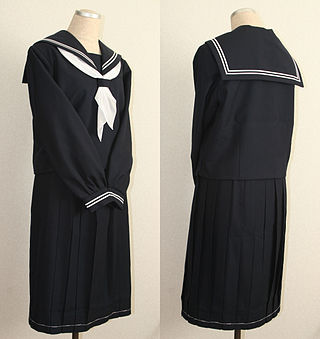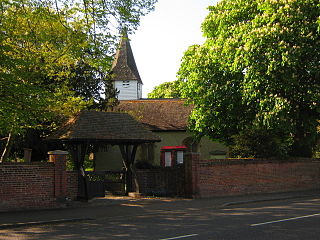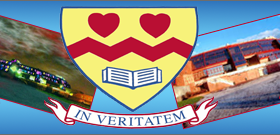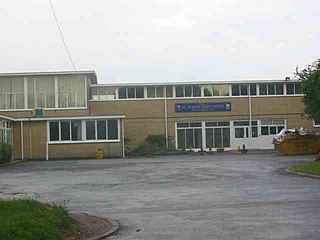
The Japanese school uniform is modeled in appearance similar to that of the European-style naval uniforms. It was first used in Japan in the late 19th century, replacing the traditional kimono. Today, school uniforms are common in many of the Japanese public and private school systems. The Japanese word for this type of uniform is seifuku (制服).
The South Wolds Academy and Sixth Form is a secondary school and sixth form with academy status, on Church Drive in Keyworth, Nottingham. It teaches students ages 11–18, and is non-denominational. It was opened in 1967, and has a capacity of 1,114 students, with a current enrolment figure of 820.

A Catholic school uniform in North America typically consists of a pleated and tartan skirt or jumper dress, Mary Jane or saddle shoes, a button-down shirt, and a sweater for girls, while boys' uniforms consist of a button-down shirt, a necktie, and dark pants. Actual school uniforms vary widely by location and individual school.
Ysgol Eirias, is a secondary school situated in Colwyn Bay, in Conwy county borough, North Wales. The school has approximately 1600 pupils and over 120 teachers and staff. The school’s name is derived from its location, the grounds of Eirias Park. The current headteacher is Zoe Evans, taking over from Sarah Sutton, who took over from Phil McTague in 2017.

Wilmington is a village and civil parish in the Borough of Dartford in Kent, England. It is located 2.7 miles south of Dartford, 3.5 miles north of Swanley and 4.3 miles south east of Bexleyheath, adjacent to the Kent border with Greater London.

Rugby High School is a selective grammar school situated in the Bilton area of Rugby, Warwickshire, England. The school motto is “She Sets Heights In Her Heart”. It takes girls aged 11–18 and boys 16–18. To attend this school, all students must have scored highly in the Eleven plus exam. It is the only state school in Warwickshire to offer Latin as a subject. In January 2023, it was rated "Good" by Ofsted.
St Edmund Arrowsmith Catholic High School is a centre of secondary education in Ashton-in-Makerfield in the Metropolitan Borough of Wigan, Greater Manchester, England. It has around 1200 pupils and is a Leading Edge school. It is also the first Secondary School in the Wigan Borough to receive the Green Flag Award.
Campion School is a leading English-language private international school in Athens, Greece, which provides an adapted British educational curriculum to approximately 650 children of foreign residents, the Greek diaspora and local Greeks, from Nursery through to Year 13. The pupils include children coming from more than 40 different countries.

Henbury High School was a comprehensive school for girls and boys aged 11 – 18 in Macclesfield, Cheshire, England, established in 1958. Henbury High closed in July 2007 and re-opened as Macclesfield High School in a new location. It had approximately 1000 pupils, and 100 members of staff. Before it became Henbury High School it was known as Broken Cross Secondary Modern School, but changed its name in 1979. It was a successful foundation school, with twin specialisms. In 1998, it was designated as a specialist technology college. In 2004, as a result of being identified as a high-performing secondary school by the DfES, the school was invited to apply for a second specialism in art and English.

Bishop Challoner School is an English independent coeducational Roman Catholic day school in Shortlands, Greater London, for children aged three to eighteen years.
The Cardinal Wiseman Catholic School, commonly known as The Cardinal Wiseman School, is a Catholic school comprising a comprehensive secondary school and sixth form located in Greenford, London, England. Its headteacher is Daniel Coyle and its student body consists of 11 to 19-year-olds.

Cardinal Newman High School is a Roman Catholic, co-educational, comprehensive secondary school located in Bellshill, North Lanarkshire, Scotland. The school was formed by the amalgamation of Elmwood Secondary, St. Saviour's High School and St. Catherine's. The school's catchment area includes Bellshill, Mossend, Viewpark, Birkenshaw and Tannochside. The feeder primary schools are St Gerard's, Sacred Heart, Holy Family and John Paul II.

St Albans Girls' School, usually referred to as STAGS, is a girls' secondary school in St Albans, Hertfordshire. It was formerly known as "St Albans Girls' Grammar School."

This article describes some of the unique features of Stonyhurst College, a Jesuit school in Lancashire, England.
The school uniform is black and white, derived from the municipal colours of Edinburgh.

School uniforms in England are worn in over 90% of primary and secondary schools in England. Parents are required to purchase the uniform which in 2015 averaged roughly £212.88 per child.
Ardscoil La Salle, "De La Salle' or "The Della" as it is referred to by staff and students, is a co-educational voluntary Catholic secondary school located on the Raheny Road in Raheny, Dublin, Ireland.

Gumley House Convent School is a Roman Catholic secondary school for girls ages 11 to 18 in Isleworth, Hounslow, West London. The school has specialisms in Business & Enterprise and Languages. On 1 March 2012 it became an academy.

Cheltenham Bournside School is a coeducational secondary school and sixth form with academy status, located in Cheltenham, Gloucestershire, England. The school was initially set up as Gloucester Road Elementary Schools for 300 students of all ages, with separate schools for girls, boys, and infants. It became Cheltenham Bournside School in 1972. The school was last inspected on 27 September 2022, and prior to this in September 2016.

School uniform is a practice that dates to the 16th century in England. Charity schools such Christ's Hospital, founded in 1552 in London, were among the first schools to use a uniform for their students. The earliest documented proof of institutionalised use of a standard academic dress dates back to 1222 when the Archbishop of Canterbury ordered wearing of the cappa clausa.













